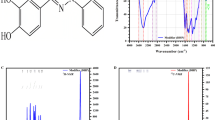Abstract
Considering of the basic properties and also the two nitrogen atoms in the structure, hydrazine hydrate was employed to be an amine additive candidate, to build a Ru(bpy) 2+3 /hydrazine electrochemiluminescence (ECL) system, and ECL of Ru(bpy) 2+3 has been employed for the determination of hydrazine hydrate in the paper. The result demonstrated that the logarithmic ECL increasing (ΔECL = ECLafter addition of hydrazine − ECLbefore addition of hydrazine) versus the logarithmic concentration of hydrazine hydrate is linear over a concentration range of 1.0 × 10−9 to 1.0 × 10−5 mol/L, on both glassy carbon and Pt electrodes in a pH 9 phosphate buffer. The hydrazine hydrate detection limit was down to 1.0 × 10−9 mol/L, comparatively lower than other detection methods. To check its applicability, the proposed method was applied to the determination of hydrazine hydrate added into a tap water sample with good reproducibility and stability. All these provide a possibility to develop a novel ECL detection method for hydrazine in water.





Similar content being viewed by others
Reference
Brown, K. L., & Gray, S. B. (2007). Electrochemical detection of hydrazine using flow injection analysis. Abstracts of papers, 233rd ACS National Meeting, Chicago, IL, United States, March 25-29, CHED-305.
Casella, I. G., Guascito, M. L. R., Salvi, A. M. L., & Desimoni, E. (1997). Catalytic oxidation and flow detection of hydrazine compounds at a Nafion/ruthenium (III) chemically modified electrode. Analytica Chimica Acta, 354, 333–341.
Collins, G. E. (1996). Gas-phase chemical sensing using electrochemiluminescence. Sensors and Actuators B: Chemical, B35, 202–206.
Dong, Y. P. (2010). Electrogenerated chemiluminescence of luminol at a carbon nanotube-perfluorosulfonate polymer (Nafion) modified gold electrode. Journal of Luminescence, 130, 1539–1545.
Guo, L. H., Fu, F. F., & Chen, G. N. (2010). Capillary electrophoresis with electrochemiluminescence detection: fundamental theory, apparatus, and applications. Analytical and Bioanalytical Chemistry, 399, 3323–3343.
Haghani, A., Eaton, A., Wan, J., Cha, Y. Y. (2008). Proceedings-water quality technology conference and exposition, hagh1/1-hagh1/17.
Hydrazine Hazard Summary (1992, 2000, 2008). United States Environmol/Lental Protection Agency. Hydrazine in Water, ASTM D 1385 – 01.
Jiang, Q., Sun, S. G., Håkansson, M., Langel, K., Ylinen, T., Suomi, J., & Kulmala, S. (2006). Electrochemiluminescence and chemiluminescence of a carboxylic acid derivative of Ruthenium (II) tris-(2,2′-bipyridine) chelate synthesized for labeling purposes. Journal of Luminescence, 118, 265–271.
Jie, G. F., Liu, P., Wang, L., & Zhang, S. S. (2010). Electrochemiluminescence immunosensor based on nanocomposite film of CdS quantum dots-carbon nanotubes combined with gold nanoparticles-chitosan. Electrochemistry Communications, 12, 22–26.
Kean, T., Miller, J. H., Skellern, G. G., & Snodin, D. (2008). Acceptance criteria for levels of hydrazine in substances for pharmaceutical use and analytical methods for its determination. European pharmacopeia scientific notes, 2, 23–33.
Lide, D. R., (2002). CRC Handbook of chemistry and physics, 83rd edition.
Liu, F. Y., Yang, X., & Sun, S. G. (2011). Determination of melamine based on electrochemiluminescence of Ru(bpy) 2+3 at bare and single-wall carbon nanotube modified glassy carbon electrodes. Analyst, 136, 374–378.
Pinter, J. S., Brown, K. L., DeYoung, P. A., & Peaslee, G. F. (2007). Amperometric detection of hydrazine by cyclic voltammetry and flow injection analysis using ruthenium modified glassy carbon electrodes. Talanta, 71, 1219–1225.
Plunkett, S., Parrish, M. E., Shafer, K. H., Shorter, J. H., Nelson, D. D., & Zahniser, M. S. (2002). Hydrazine detection limits in the cigarette smoke matrix using infrared tunable diode laser absorption spectroscopy. Spectrochim Acta A, 58A, 2505–2517.
Preece, N. E., Forrow, S., Ghatineh, S., Langley, G. J., & Timbrell, J. A. (1992). Determination of hydrazine in biofluids by capillary gas chromatography with nitrogen-sensitive or mass spectrometric detection. Journal of Chromatography, 573, 227–234.
Richter, M. M. (2004). Electrochemiluminescence (ECL). Chemical Reviews, 104, 3003–3036.
Su, M., & Liu, S. Q. (2010). Solid-state electrochemiluminescence analysis with coreactant of the immobilized tris(2,2′-bipyridyl) ruthenium. Analytical Biochemistry, 42, 1–12.
Sun, S. G., Yang, Y., Liu, F. Y, Fan, J. L., Peng, X. J., Kehr, J., Sun, L. (2009a). Intra- and intermolecular interaction ECL study of novel ruthenium tris-bipyridyl complexes with different amine reductants. Dalton Transactions, 7969–7974.
Sun, S. G., Yang, Y., Liu, F. Y., Pang, Y., Fan, J. L., Sun, L., & Peng, X. J. (2009). Study of highly efficient bimetallic ruthenium tris-bipyridyl ecl labels for coreactant system. Analytical Chemistry, 81, 10227–10231.
Sun, S. G., Yang, Y., Liu, F. Y., Fan, J. L., Kehr, J., Sun, L., & Peng, X. J. (2010). ECL performance of ruthenium tris-bipyridyl complexes covalently linked with phenothiazine through different bridge. Dalton Transactions, 39, 8626–8630.
Thomas, L. C., Chamberlin, G. J. (1974). Colorimetric chemical analytical methods, 8th ed., Method I, p195.
Zheng, X. W., Zhang, Z. J., Guo, Z. H., & Wang, Q. (2002). Flow-injection electrogenerated chemiluminescence detection of hydrazine based on its in-situ electrochemical modification at a pre-anodized platinum electrode. Analyst, 127, 1375–1379.
Acknowledgments
This work was financially supported by the National Natural Science Foundation of China (no. 21272030), the Fundamental Research Funds for the Central Universities (no. DUT11LK21), the Open Research Fund of State Key Laboratory of Bioelectronics, Southeast University, the State Key Laboratory of Materials-Oriented Chemical Engineering, Nanjing University of Technology, the Open Project Program of Key Laboratory of ECO-Textiles (Jiangnan University), the Ministry of Education (no. KLET1102), and the China Postdoctoral Science Foundation (no. 20100471434).
Author information
Authors and Affiliations
Corresponding author
Electronic supplementary material
Below is the link to the electronic supplementary material.
Fig. S1
Cyclic voltammetric curves of 0.1 μmol/L hydrazine in 0.1 mol/L phosphate buffer (pH 9) at GC electrode, Scan rate: 150 mV/s. (DOCX 32 kb)
Fig. S2
Dependence of the logarithmic ECL increasing versus the logarithmic concentration of hydrazine hydrate with 0.1 mol/L Ru(bpy) 2+3 in 0.1 mol/L phosphate buffer (pH 9) at Pt electrode. (DOCX 32 kb)
Rights and permissions
About this article
Cite this article
Liu, F., Li, W., Li, F. et al. Determination of hydrazine hydrate based on electrochemiluminescence of Ru(bpy) 2+3 . Environ Monit Assess 185, 4153–4158 (2013). https://doi.org/10.1007/s10661-012-2857-9
Received:
Accepted:
Published:
Issue Date:
DOI: https://doi.org/10.1007/s10661-012-2857-9




